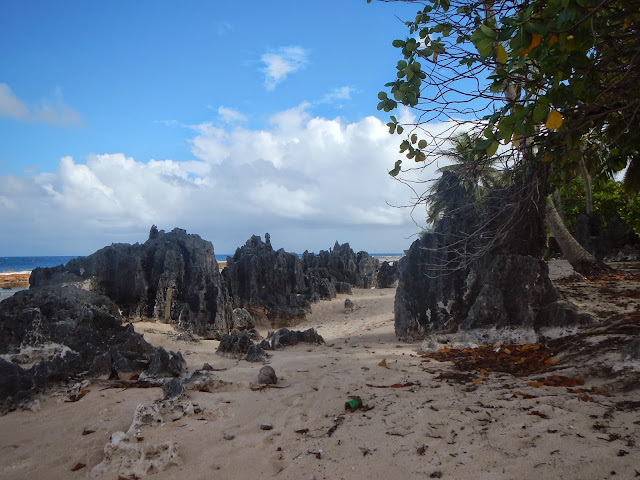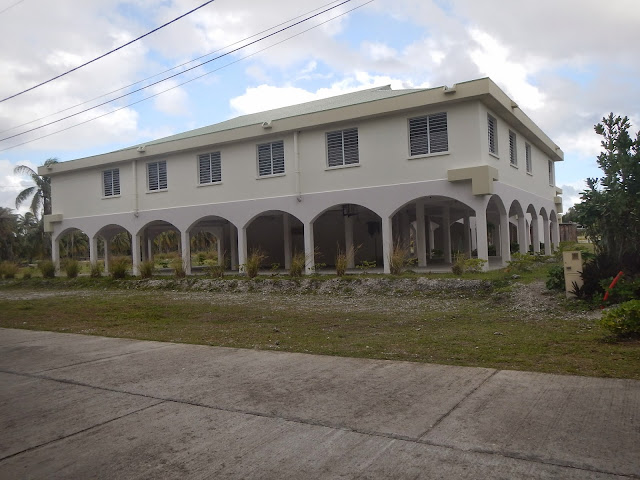Travel is fatal to prejudice, bigotry,
And narrow mindedness.
Mark Twain
 |
| Ragged coral reefs along sandy beach |
Little is to be said of Tikehau, our first atoll in the
Tuomatus. The word is that in 1987
Jacques Cousteau studied its lagoon and discovered it held the greatest variety
and concentration of fish he’d seen anywhere else in French Polynesia. He also declared it one the richest atolls on
earth… Hence some of the fame this small place lives off decades later.
 |
| At attention like sentinels |
 |
| Taller than Mike |
The little we have to say of Tikehau matches the little
there is to do here = very simple living on a very small space. The motu we are on is only 4 km long by, at
its widest, 0.5 km wide. Four hundred
people live on this motu; with an airport and the largest population of the
Tikehau motus. With all motus combined
the last census counted 547 people but our host Henhere (Henry) thinks the
number is nearer to 700.
 |
| Atoll has its own shelter for everyone in case of tsunami or cyclone |
People live off copra, farming, and tourism. A few work at the airport, the airline, the
police, the town hall, the primary school or own pensions or casse-croutes
(snack bars). Other than that there is
fishing, but few do it commercially, and diving to complete the set of
activities one can take part in. There
is not even a gas station serving the island.
People fill up their vehicles at the supply boat when it comes around
about every other week.
 |
| Shell necklaces hung all around tomb |
It is made especially more peaceful since many kids are gone
to Rangiroa less than 10 miles away, a much larger atoll. Tikehau depends on Rangiroa for most
things. The children are to partake in
pirogue, basketball, javelin throwing and other sport related contests of the
Tuomatus, some of it in preparation for the Heiva.
The Heiva is a huge annual event for all of French Polynesia
where they compete in singing, dancing, playing music, throwing javelin,
lifting rocks, carrying fruits, coring coconuts, canoeing, paddling pirogues,
climbing palm trees, etc. It usually
ends mid July and is rich in culture and deep in folklore, taken away far too
long by Christianity. Thankfully they
are regaining their identity and their traditional way of life.
Back to Tikehau, there are just no kids around for a week and
it’s eerily quiet and ghost-town like.
Our host and his wife Colette Eugenie (after which Pension
Colette is named) offer great dinners with sometimes live music played by Henry. He sings mostly Tahitian songs while he plays
the tacata (mini-guitar). He can also
play the ukulele and the guitar but prefers the tacata because it is mellower,
smoother sounding than the ukulele and not as large as a guitar. At times he’ll switch to French. He mixes it up with a few stories and
jokes. He is definitely a bon-vivant
(life loving) and loves sharing all he knows about French Polynesia. We had very small eggplants and langoustes
both from the atoll and each was delicious.
Henry’s grandfather was Chinese (many came here around 1918) and he laughs
just like them – a very contagious laugh.
He tells us about another use for coconut shells we hadn’t
heard of yet. They used to burn the
shells to make coconut coals. The coals
were used for ironing. They were put
inside irons to warm them up. Coconut
charcoal was used to filter water as well.
We notice a new thing on this atoll we hadn’t seen yet in
the Society Islands or in the Marquesas.
Each family seems to dig a large hole to bury their garbage. They recycle glass, plastic, cans, aluminum,
and batteries but the rest they mostly burn or bury. It doesn’t look very appealing to see that
many open pits filled with detritus in various stages of decomposition or burning. It also seems to attract more bugs – namely flies
and mosquitoes when they fill up with water.
The lagoon is much larger than imagined. Even with our beach bungalow facing the
lagoon side, not the ocean, we could think we are on the ocean considering the
size of the waves and no view of any type of land in front of us closing the
circle of the atoll. The atoll is 26 km
across with a circumference of 96 km, we cannot see the other side and it feels
like the open space of an ocean.
The problem with atolls is that even though they can be
quite large (we are not on a very large one in the scheme of things), they are
made of several detached or semi detached islets called motus separated by
channels. On Tikehau there are about 20+
islets. If one is travelling by land
like we are at the moment, one is usually stuck on just one motu, not allowing
a visit of the whole atoll unless travelling by water. It seems it would be much better to visit
atolls by boat and kayak.
We are told there is a bird island, an island with a Chinese
group called Eden that grows organic food, a shrimp farm, large manta rays in
the pass, etc but for the first time in seven weeks the weather makes it
impossible for us to go far. Wind,
waves, and rain combined to make it a mostly stay near the bungalow and update
the blog kind of time, which is urgently needed (still over one month behind).
The atoll is also known for its pink sand hence the nickname
Pink Sand Island. Although there is a
hint of pink, I cannot say it would be so remarkable as to make a trip to see
it. It’s more like a hint of pink on the
beige/white sand, still beautiful but unexceptional.
 |
| Upside down like flower |
During our last dinner at Pension Colette (Aiko Motel) Henry
tells us about eating dogs. It still
exists in the Tuomatus especially for people in need. Henry has no qualm eating them especially if
they are misfits or misbehaving. This is
not a subject easily approached by them due to the bad publicity it has (a
little akin to cannibalism) but we’ve heard of other cases in other Tuomatus as
well. To each their own culture and
beliefs.
He recounts his days working the copra when he and his
brother used to bag about 2,000 kilos of copra in one day! That once his brother left, he and his wife
carried on but that they bagged less since she wasn’t as strong as his brother
– nevertheless still collecting 1,600 kilos…
He tells us of a time more than 75 years ago when the locals
would move from the north end of the atoll (in the vicinity of the current
village) to the south end of the atoll they call the "sector" every 6 months to
give the place a rest. They would bring
everything along, kids, animals, tools, etc.
They would return to more fish in the lagoon and healthier environment
all around. It would be too difficult
today for it would necessitate duplicating churches, schools, etc. It was much simpler then.
He informs us that in 1906 a huge flood caused by a cyclone
destroyed the town so they relocated to their current location. It is not located on the largest motu of
Tikehau but it is the largest close to the pass entering/leaving the
atoll.
Finally he shared that Tikehau was really called Tiehau
(without the k) due to administrators of the time not being able to say it
correctly during speeches. The old
timers still say Tiehau. Originally named after a man Tii and a woman Hau, who combined their names for their children, Tiehau became Tikehau meaning "peaceful Landing." And it is exactly what you feel when you arrive in this sleepy paradise...
 |
| The Bell of Hina (from some local legend) |
Our hosts say their goodbyes with shell necklaces and kisses
on the cheeks. They explain how sad it
makes them to know these traditions are dying.
It is true that in 12 pensions, we’ve only received 2 flower necklaces (both
made by our hosts) upon arrival and 3 shell necklaces upon departure (one was
happier to see us go?). We kindly remember
the ones who took the time to make this special gesture of kindness and welcome
towards us.
No comments:
Post a Comment
We are always happy to hear from you but at times it may take a while to get a reply - all depends if we have access to the internet.